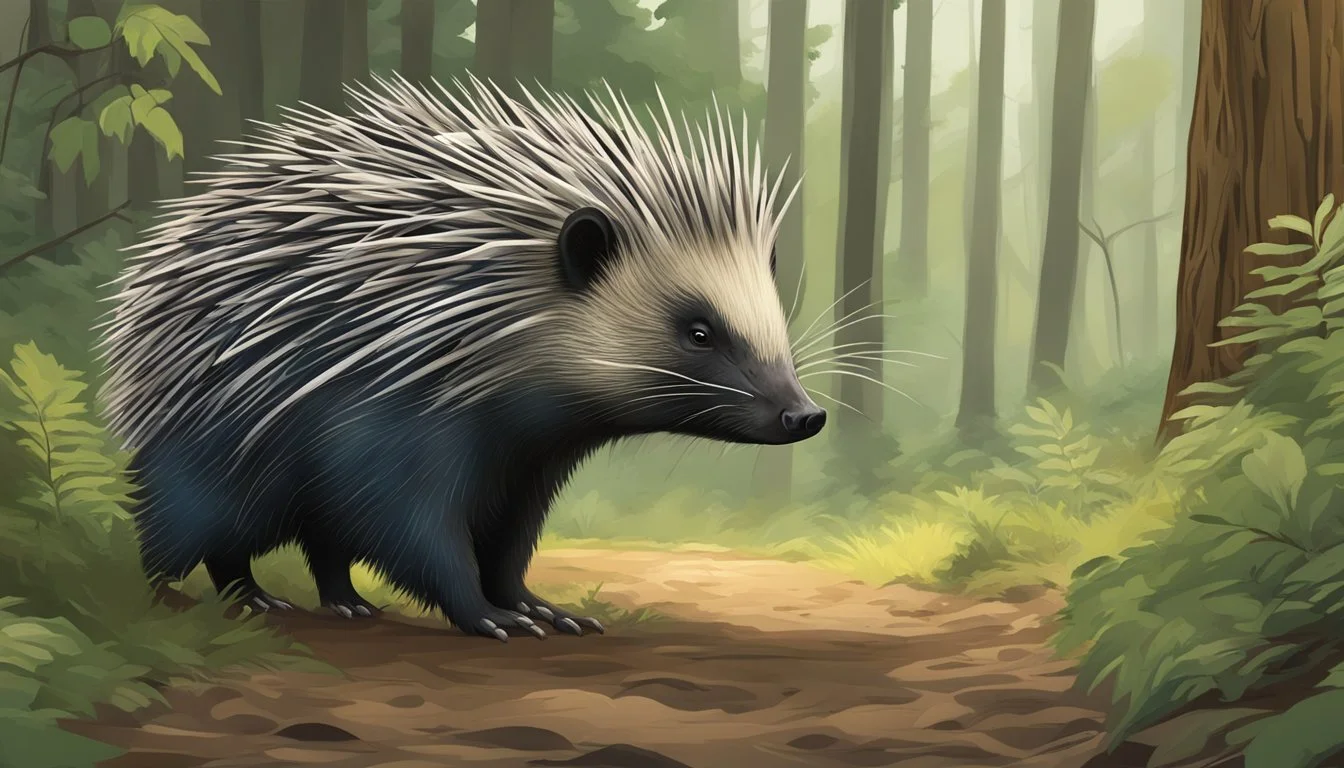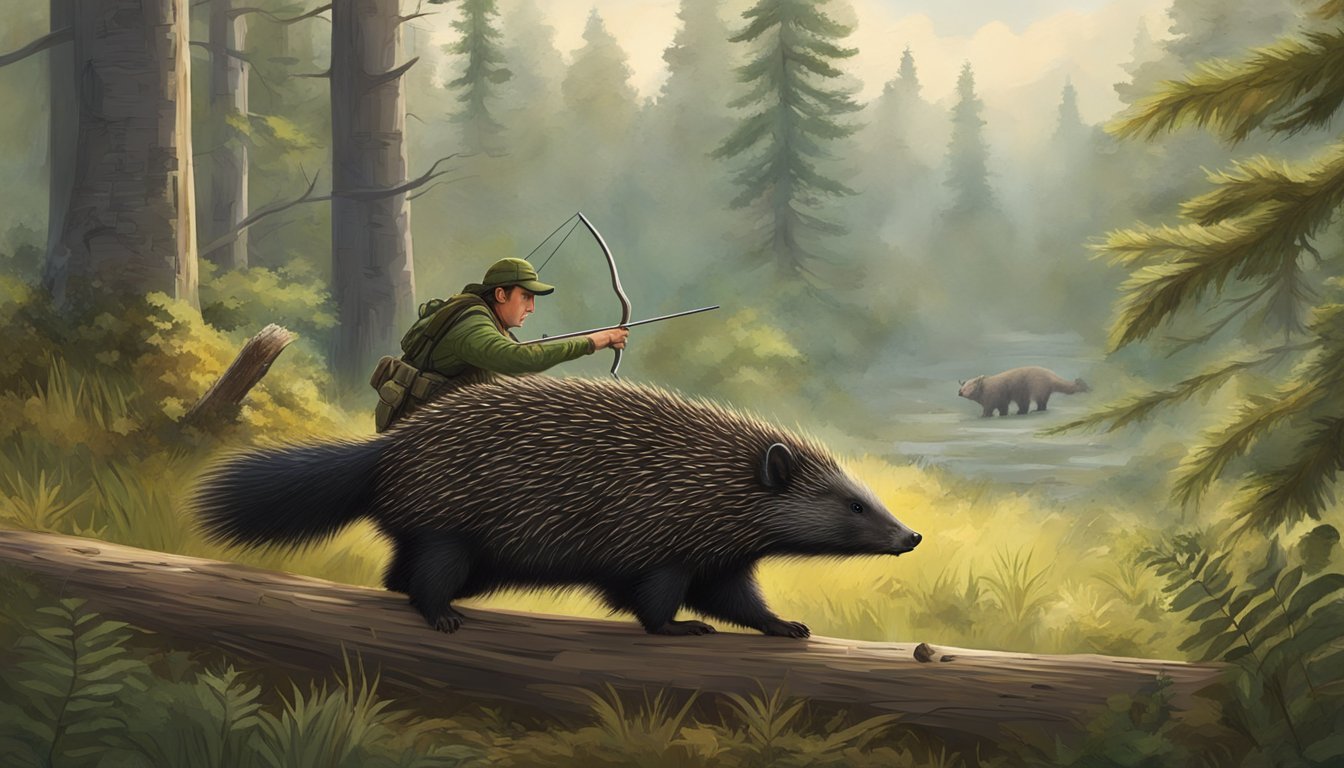Porcupine Hunting for Beginners
Essential Tips for First-Time Hunters
Porcupine hunting is an activity that caters to those with an interest in wildlife management and sustainable hunting practices. Porcupines, with their distinct quills and herbivorous diet, are a unique game species found in various parts of North America. They tend to weigh between 15 and 35 pounds and consume a diet primarily composed of tree bark, needles, buds, leaves, and rose hips. For beginners considering hunting as a venture, understanding the habits and ecological role of porcupines is crucial to ensure both a successful and ethical hunt.
When setting out on a porcupine hunting expedition, one should be aware that these creatures are slow-moving and have relatively poor eyesight, making them easier to approach than other wildlife. However, they are not defenseless; their quills can prove dangerous if proper caution is not exercised. Hunters typically use firearms like shotguns or small-caliber rifles for a quick and humane kill. Given their nocturnal nature, finding porcupines generally involves scouting near food sources such as trees and shrubs during the night hours.
Understanding local regulations and seasons for small-game hunting is essential in planning a porcupine hunt. While they may not be the most conventional prey, porcupines are recognized by some hunters for their meat and are sometimes sought after in survival situations. It's paramount that those new to hunting undertake this activity with respect for the animal and the environment, adhering to the principles of responsible wildlife management.
Understanding Porcupines
Porcupines are notable for their unique defense mechanisms and play a significant role in their ecosystems. Understanding their behaviors and characteristics is essential for wildlife enthusiasts and novices in porcupine hunting.
Porcupine Fundamentals
Porcupines are large rodents with a coat of sharp quills that defend them against predators. They belong to the family Erethizontidae in North America and Hystricidae in the Old World.
Habitat and Range
They inhabit a range of environments, from deserts to forests. In North America, they are commonly found in coniferous forests and the shrublands of the western United States, as well as mixed forest areas with an abundance of trees.
Physical Characteristics
A porcupine's most distinguishing feature is its quills, which are actually modified hairs coated with thick plates of keratin. These quills can be up to 30 centimeters long and are deliberately detachable when predators encounter them. The color of a porcupine's fur varies, blending with the forested habitats to provide camouflage.
Behavior and Diet
Primarily nocturnal and herbivorous, porcupines feast on tree bark, leaves, and fruit. Their strong, chisel-like teeth allow them to gnaw on hard surfaces and they can cause significant damage to trees.
Reproduction and Lifecycle
The porcupine mating season occurs in late summer to early fall, with a gestation period of about seven months. Females give birth to one offspring, known as a porcupette, which is born with soft quills that harden within a few days.
Porcupines and the Ecosystem
Porcupines play a crucial role in their habitats by aiding in the control of vegetation and providing food for predators. However, their taste for tree bark can also make them a threat to forestry management.
Encountering Porcupines in the Wild
If encountered, it is encouraged to maintain a safe distance, as porcupines cannot throw their quills but can embed them in skin with their tails if threatened.
Conservation Status
Generally, porcupines are not considered endangered, but habitat loss and hunting can affect local populations. Effective wildlife management and conservation practices ensure their survival and mitigate human-porcupine conflicts.
Planning Your Hunt
Before embarking on a porcupine hunting expedition, it's crucial to ensure that you're well-informed about the legal requirements, equipped with the necessary gear, and familiar with the porcupine's habits and habitats.
Legal and Ethical Considerations
All hunters must obtain the appropriate licenses and permits as required by local wildlife management authorities. Porcupine hunting regulations can vary, so it is their responsibility to be aware of and adhere to all specific legislation. Hunters should also practice ethical hunting by only pursuing porcupine during open seasons and using humane methods to dispatch the animal.
Hunting Gear and Preparation
Successful porcupine hunting requires the right gear. Hunters should wear suitable clothing for the weather, usually layers that can be adjusted with changing temperatures. They will need a firearm that is suitable for small game—typically a .22 caliber rifle or a shotgun with small game loads will suffice. Additional tools like headlamps or flashlights are important as porcupines are nocturnal.
Best Times and Locations
Porcupines are most active at night, especially during the winter months when their signs are easier to track in the snow. They are typically found in wooded areas where they feed on the bark of trees. Hunters should look for areas with signs of bark damage or droppings to locate porcupine habitats.
Hunting Strategies and Techniques
A stealthy approach is important when hunting porcupine due to their keen senses. Learning and using proper tracking techniques can lead a hunter to locate a porcupine more effectively. Since they move slowly, a patient and deliberate strategy is often the most successful.
Safety Precautions
While porcupines do not pose a large threat to humans, hunters should still exercise caution. They should be knowledgeable about first aid in case of quill injuries and wear protective clothing. It is also wise to let someone know your hunting location and expected return time.
Porcupine Tracking and Signs
Identifying porcupine tracks and signs is crucial for locating them. Hunters should look for small roundish droppings, tracks in the snow or mud, and trees with the bark stripped away. Detecting these signs can lead to successful tracking of porcupines.
Field Dressing and Processing
Field dressing and processing are essential steps in hunting porcupines, aimed at preserving the quality of the meat. It is a process that requires attention to detail and proper technique.
Field Dressing a Porcupine
When field dressing a porcupine, the first step is gutting. Hunters must approach gutting carefully to avoid damaging the edible meat. Here is a concise step-by-step guide:
Lay the porcupine on its back and make a careful incision from the bottom of the rib cage to the pelvis.
Remove organs gently, being mindful of quills, which can complicate the process.
Transporting and Processing
Once field dressed, the porcupine should be transported with care to avoid contamination. Keeping the carcass cool and clean is crucial during transportation. For processing:
Hang the porcupine: Helps in draining blood and easing the skinning process.
Skin and quarter: Perform with precision to retain meat quality.
Cooking and Recipes
Porcupine meat is a unique small game delicacy that benefits from simple yet effective cooking methods. Here are techniques and ideas for recipes:
Roasting or stewing: Best methods to cook porcupine meat, making it tender.
Herbs and seasonings: Complement the gamey taste without overpowering it.
Recipes should highlight the natural flavors while ensuring the meat is cooked thoroughly to appropriate temperatures for safe consumption.
Understanding the Impact of Porcupine Hunting
When engaging in porcupine hunting, it is important to consider its various impacts, from population dynamics to ecosystem interactions and ethical obligations.
Impact on Porcupine Populations
Porcupine hunting can exert significant pressure on local populations if not managed carefully. Sustainable hunting practices should be employed to maintain stable population numbers, ensuring that porcupine harvest rates do not exceed their natural reproductive capacity.
Impact on Local Ecosystems
The removal of porcupines through hunting can affect the ecosystem. As porcupines are herbivores, their feeding habits play a role in seed dispersal and vegetation management. Their removal could lead to unforeseen changes in plant composition, potentially impacting other wildlife.
Ethical Hunting Practices
Ethical considerations in hunting involve ensuring that methods used are humane and that the animal is not endangered or suffering unnecessary stress. Responsible hunters are part of wildlife conservation efforts and aim for sustainable hunting that does not disrupt natural food chains or predator-prey dynamics.
Regulations and Management
Legislation and regulations guide porcupine hunting by establishing measures for conservation and sustainable management of wildlife resources. Hunting laws vary by region, so it is imperative to understand and adhere to local wildlife management policies and obtain the correct permits where necessary.
Additional Considerations
After successfully hunting a porcupine, it is essential to know the uses of its meat and quills, as well as how to handle chance encounters with these creatures in the wild.
Cooking with Porcupine Meat
Porcupine meat, known for its versatility, can be a unique addition to a hunter's culinary ventures. When preparing porcupine meat, safety is paramount; it should be thoroughly cooked to prevent any potential disease transmission. Beginners can start with simple recipes such as stews or roasts that bring out the flavor of the meat and tenderize its texture. It is advisable to consult wild game cooking guides for specific instructions.
Using Porcupine Quills in Crafts
The quills of a porcupine are not only a distinctive defense mechanism but also a valued material in crafts. Before using quills, it is important to clean and sort them. They can be dyed and then utilized in traditional crafts such as jewelry or embellishments on garments. Those undertaking quillwork should handle the quills with care to avoid injury.
Non-Hunting Encounters with Porcupines
When one encounters a porcupine without the intention of hunting, maintaining safety is crucial due to their sharp quills. Do not attempt to touch or handle a porcupine, as their quills can easily become embedded in skin. In such situations, it is best to stay calm and give the animal enough space to retreat. Observing from a distance minimizes the risk of a defensive interaction.




